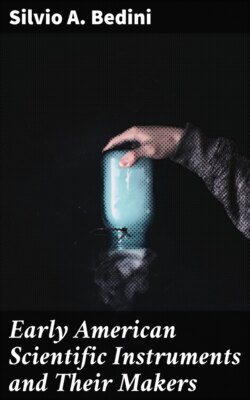Читать книгу Early American Scientific Instruments and Their Makers - Silvio A. Bedini - Страница 21
На сайте Литреса книга снята с продажи.
Post-Revolutionary Immigrant Makers
ОглавлениеTable of Contents
A large proportion of the English craftsmen who came to the American Colonies after the Revolution settled in Philadelphia, There was John Gould for instance, a mathematical instrument maker from London who had opened a shop at 47 Water Street by 1794. He sold nautical, surveying, and optical instruments as well as mirrors, presumably all imported from England. He moved to 70 South Front Street "At the Sign of the Quadrant" in 1796. He was succeeded in business in 1798 by Thomas Whitney, another emigrant from London. Whitney made and sold instruments (see fig. 85) in Gould's former shop, and featured also a vast array of department store merchandise. John Whitney, who may have been his son, was listed at the same address in the Philadelphia directory of 1801 as a "Mathematical Instrument Maker and Optician."[19]
In the Philadelphia directory and register for 1821 Thomas Whitney advertised that he
… presents his sincere thanks to his friends and the public and respectfully soliciting the continuation of their favors, wishes to inform them that he has devoted his attention principally to the making of surveying compasses for 16 years past, and has made 500 of them; the good qualities of which are well known to many surveyors, in at least 16 of the States and Territories of the Union … [he also makes] many other instruments, protractors, gunner's Calibers and quadrants, etc.
George Evans was another instrument maker who arrived from London after the end of the Revolution. He established himself in a shop at 33 North Front Street in 1796, where he sold imported instruments as well as stationery, Bibles, and cloth. He died in 1798.[20]
Thomas Dring, who migrated from England, settled in Westtown Township of Chester County, Pennsylvania, where he was first noted in the tax records of 1786. He married Hanna Griffith, a native of the region, and their son, Jeptha Dring, subsequently was mentioned as a carpenter by trade, and a vagrant by inclination, who could quote Shakespeare from memory. According to local legend, Dring raised money from a number of townspeople for the purpose of purchasing clocks for them in England. He set sail for his homeland in about 1798 and never returned.
Although the tax records for 1796 described Dring as an "Optician" he was also a clockmaker and maker of scientific instruments. At least three of his tall-case clocks have survived, and a stick type of barometer which he made for Edward and Hannah Hicks in 1796. The instrument is now in the collection of the Chester County Historical Society. It measures 39 inches in height, and is signed on the thermometer dial THOMAS DRING/West Chester. This instrument (fig. 14) is one of the very rare barometers produced in America in the 18th century.
Another craftsman who emigrated from England was Robert Clark, who opened a shop at 5–½ Church Street in Charleston, South Carolina, in 1785. In that year he announced himself as a
Math., Optical and Philosophical Instruments maker and Clockmaker from London … As the Advertiser has lately had an opportunity of working and receiving instruction under the first masters in the above branches in Great Britain, flatters himself that he shall give satisfaction to those who may be pleased to favor him with their orders … for Surveyors compasses, Quadrants, Telescopes, Microscopes, Spirit Levels, etc.[21]
W. Fosbrook was another craftsman originally from London. He was a cutler and maker of surgical instruments, with a shop in Beekman's Slip in New York City in 1786 or earlier. He specialized in leg irons and rupture trusses, and he made instruments and files for setting the teeth as well as standard items for surgeons.[22]
Figure 14.—Barometer made in 1796 by Thomas Dring of West Chester, Pa., for Edward and Hannah Hicks. Photo courtesy the Chester County Historical Society.
Several immigrant instrument makers established themselves in Philadelphia during the same period. John Denegan (or Donegan), stated to have been "late from Italy," moved his shop in March 1787 to the corner of Race and Fourth Streets at "the sign of the Seven Stars".[23] There he made barometers and thermometers as well as glasses for philosophical experiments. It seems too much of a coincidence that in October 1787 an instrument maker named Joseph Donegany established a shop at 54 Smith Street in New York City,[24] where—according to an advertisement in the October 17, 1787, issue of The New York Daily Advertiser—he made "thermometers, barometers and sold hydrostatic Bubbles and hygrometers for proving spirits, and also … glasses for experimental purposes." It is probable that Denegan and Donegany were one and the same; since Denegan was stated to have been of Italian origin, the name may originally have been "De Negani."
Joseph Gatty advertised himself as an "Artist from Italy" with a shop at 341 Pearl Street in New York City where he "made and sold every simple and compound form of barometer and thermometer as well as curious Hygrometers for assaying spirits which show the actual strength with the greatest precision and are not liable to be corroded, in addition to several new Philosophical Instruments of his own invention, and all types of artificial fireworks."[25] By 1796 Gatty (or Gatti?) had moved to Philadelphia where he had a shop at 79 South Front Street and advertised the same items that had appeared in his advertisements in New York. The Philadelphia directory for 1800 listed Gatty as a "Weather Glass Maker."[26]
